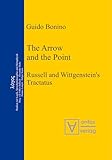The Arrow and the Point : Russell and Wittgenstein’s Tractatus / Guido Bonino.
Material type: TextSeries: Logos : Studien zur Logik, Sprachphilosophie und Metaphysik ; 11Publisher: Berlin ; Boston : De Gruyter, [2013]Copyright date: ©2008Description: 1 online resource (372 p.)Content type:
TextSeries: Logos : Studien zur Logik, Sprachphilosophie und Metaphysik ; 11Publisher: Berlin ; Boston : De Gruyter, [2013]Copyright date: ©2008Description: 1 online resource (372 p.)Content type: - 9783110323917
- 9783110324280
- 192 22
- B3376.W563 T73221 2008
- online - DeGruyter
- Issued also in print.
| Item type | Current library | Call number | URL | Status | Notes | Barcode | |
|---|---|---|---|---|---|---|---|
 eBook
eBook
|
Biblioteca "Angelicum" Pont. Univ. S.Tommaso d'Aquino Nuvola online | online - DeGruyter (Browse shelf(Opens below)) | Online access | Not for loan (Accesso limitato) | Accesso per gli utenti autorizzati / Access for authorized users | (dgr)9783110324280 |
Frontmatter -- Contents -- Introduction -- Part I. Falsehood, negation, and logical constants -- 1. Russell: from the binary to the multiple-relation theory of judgment -- 2. The reasons leading to the multiple-relation theory of judgment -- 3. Meinong and Russell on being and existence -- 4. Wittgenstein on bivalence and bipolarity -- 5. Russell on negation -- 6. Wittgenstein (and Russell) on negation and bipolarity -- 7. Sense, meaning, and Sachverhalte -- 8. Symmetry and asymmetry between true and false -- 9. The Grundgedanke: Wittgenstein on logical constants -- 10. Molecularity and Sachlage -- Part II. Facts -- 1. Russell and Bradley: the unity of the proposition and the doubleaspect problems -- 2. Difficulties and further developments of the multiple-relation theory of judgment -- 3. Judgment and logical form -- 4. Wittgenstein and the failure of the Theory of Knowledge -- 5. Facts, things, and bipolarity -- 6. Troubles with Sachverhalte -- 7. The nature of the proposition -- 8. Pictures, propositions, thoughts, and projection -- Part III. Objects and form -- 1. Atomism and objects -- 2. Relations, objects, and form -- 3. Sense and nonsense -- 4. Russell and Wittgenstein on the nature of philosophy -- References -- Backmatter
restricted access online access with authorization star
http://purl.org/coar/access_right/c_16ec
The book aims at a comprehensive account of the relationship between Wittgenstein’s Tractatus Logico-Philosophicus and Russell’s philosophy as it developed between 1903 and 1918. The focus is on the central nucleus of the Tractatus, i.e., on its ontology and the picture theory of language. On Russell’s side, the multiple-relation theory of judgment has been chosen as the leading theme around which the presentation of several other issues is organized. Whereas the similarity between Russell’s and Wittgenstein’s problems is pointed out, the deep difference between their solutions is acknowledged, in particular with reference to the opposition between objects and names on the one hand, and facts and propositions on the other.
Issued also in print.
Mode of access: Internet via World Wide Web.
In English.
Description based on online resource; title from PDF title page (publisher's Web site, viewed 28. Feb 2023)


